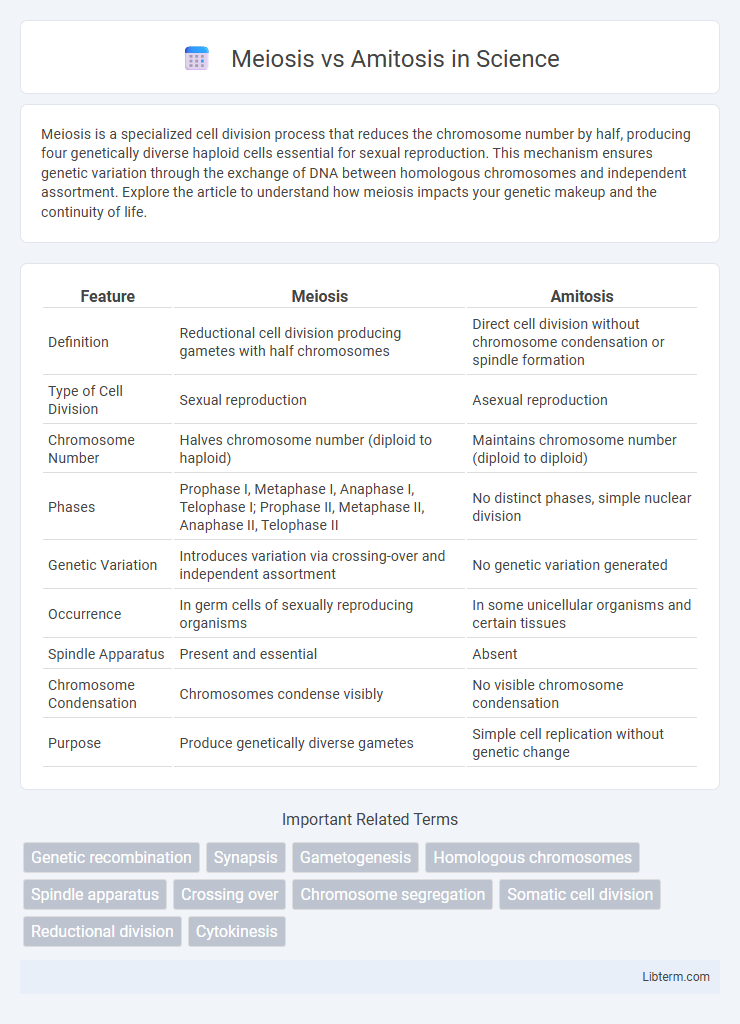Meiosis is a specialized cell division process that reduces the chromosome number by half, producing four genetically diverse haploid cells essential for sexual reproduction. This mechanism ensures genetic variation through the exchange of DNA between homologous chromosomes and independent assortment. Explore the article to understand how meiosis impacts your genetic makeup and the continuity of life.
Table of Comparison
| Feature | Meiosis | Amitosis |
|---|---|---|
| Definition | Reductional cell division producing gametes with half chromosomes | Direct cell division without chromosome condensation or spindle formation |
| Type of Cell Division | Sexual reproduction | Asexual reproduction |
| Chromosome Number | Halves chromosome number (diploid to haploid) | Maintains chromosome number (diploid to diploid) |
| Phases | Prophase I, Metaphase I, Anaphase I, Telophase I; Prophase II, Metaphase II, Anaphase II, Telophase II | No distinct phases, simple nuclear division |
| Genetic Variation | Introduces variation via crossing-over and independent assortment | No genetic variation generated |
| Occurrence | In germ cells of sexually reproducing organisms | In some unicellular organisms and certain tissues |
| Spindle Apparatus | Present and essential | Absent |
| Chromosome Condensation | Chromosomes condense visibly | No visible chromosome condensation |
| Purpose | Produce genetically diverse gametes | Simple cell replication without genetic change |
Introduction to Cell Division
Cell division is a fundamental biological process essential for growth, development, and reproduction in living organisms. Meiosis is a specialized form of cell division that reduces the chromosome number by half, producing four genetically diverse haploid cells crucial for sexual reproduction. Amitosis, a simpler and less common form of division, involves the direct splitting of the nucleus and cytoplasm without the complex stages or genetic recombination found in meiosis.
Overview of Meiosis
Meiosis is a specialized form of cell division that reduces the chromosome number by half, producing four genetically diverse haploid cells essential for sexual reproduction. This process involves two consecutive divisions, meiosis I and meiosis II, ensuring genetic recombination and independent assortment of chromosomes. Meiosis contributes to genetic variation, which is critical for evolution and adaptation in sexually reproducing organisms.
Overview of Amitosis
Amitosis is a simple form of cell division where the nucleus and cytoplasm divide directly without the formation of chromosomes or spindle fibers, commonly observed in prokaryotic cells and certain unicellular eukaryotes. Unlike meiosis, amitosis does not involve genetic recombination or reduction of chromosome number, resulting in two genetically identical daughter cells. This process supports rapid cellular replication but lacks the genetic diversity generated by meiotic division.
Key Differences Between Meiosis and Amitosis
Meiosis is a specialized cell division process that produces four genetically diverse haploid cells, essential for sexual reproduction and maintaining chromosome number across generations. Amitosis is a simpler, direct cell division without spindle formation or chromosomal alignment, resulting in two genetically identical diploid daughter cells, commonly observed in certain unicellular organisms and tissues. Key differences include meiosis involving two sequential divisions with genetic recombination, whereas amitosis bypasses these steps, leading to less genetic variation and simpler cellular replication.
Phases and Processes Involved
Meiosis involves two sequential divisions, meiosis I and meiosis II, each with distinct phases: prophase, metaphase, anaphase, and telophase, facilitating reductional and equational division to produce haploid gametes. Amitosis bypasses the typical mitotic spindle formation and chromosomal alignment, featuring direct nuclear and cytoplasmic division without distinct phases or chromosomal condensation. The precise orchestration of chromosomal pairing, crossing over in meiosis contrasts with the simplistic, direct splitting characteristic of amitosis, highlighting their fundamental differences in complexity and genetic outcomes.
Genetic Variation: Meiosis vs Amitosis
Meiosis generates genetic variation through processes like crossing over and independent assortment of homologous chromosomes, resulting in genetically diverse gametes. Amitosis involves direct nuclear division without chromosome pairing or recombination, producing genetically identical daughter cells and no variation. Consequently, meiosis is vital for genetic diversity in sexual reproduction, whereas amitosis maintains genetic stability in certain single-celled organisms.
Biological Significance and Roles
Meiosis is essential for sexual reproduction, reducing the chromosome number by half to produce haploid gametes, ensuring genetic diversity and species evolution. Amitosis, a simpler form of cell division, occurs mainly in unicellular organisms and some animal cells, facilitating rapid population growth without genetic variation. The biological significance of meiosis lies in promoting genetic recombination and stability of chromosome number across generations, while amitosis supports basic cellular proliferation and tissue maintenance.
Occurrence in Living Organisms
Meiosis occurs primarily in eukaryotic organisms, especially during the formation of gametes in animals, plants, and fungi, facilitating sexual reproduction and genetic diversity. Amitosis takes place mainly in unicellular organisms such as protozoa and some simple multicellular organisms, involving direct cell division without chromosome condensation. The occurrence of meiosis is essential for maintaining chromosome number across generations, while amitosis supports rapid cell proliferation in simpler life forms.
Evolutionary Implications
Meiosis introduces genetic diversity through homologous recombination and independent assortment, driving evolutionary adaptation and speciation in sexually reproducing organisms. Amitosis, a simpler form of cell division found in some unicellular eukaryotes and prokaryotes, produces genetically identical offspring, limiting variation but allowing rapid population expansion. The evolutionary advantage of meiosis lies in its role in enhancing genetic variability, which is crucial for survival in changing environments, whereas amitosis supports stability in stable, resource-rich niches.
Summary Table: Meiosis vs Amitosis
Meiosis is a specialized form of cell division producing four haploid gametes with genetic recombination, crucial for sexual reproduction and genetic diversity. Amitosis is a simpler, direct cell division without chromosome pairing or crossing over, resulting in two genetically identical daughter cells, typical in some unicellular organisms and certain tissues. Key differences include meiosis's two divisions versus amitosis's single division, presence of synapsis and chiasmata in meiosis, and the reduction of chromosome number only in meiosis.
Meiosis Infographic

 libterm.com
libterm.com